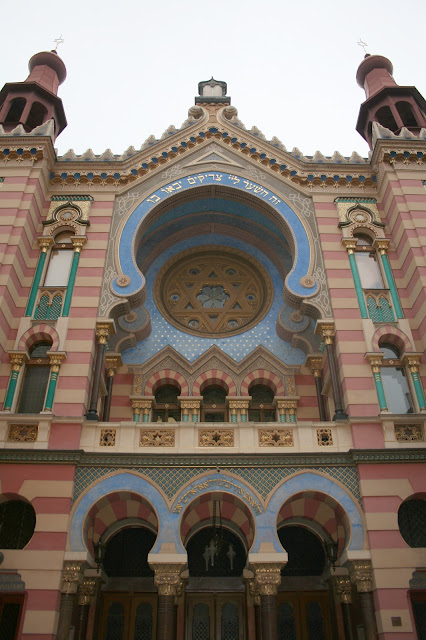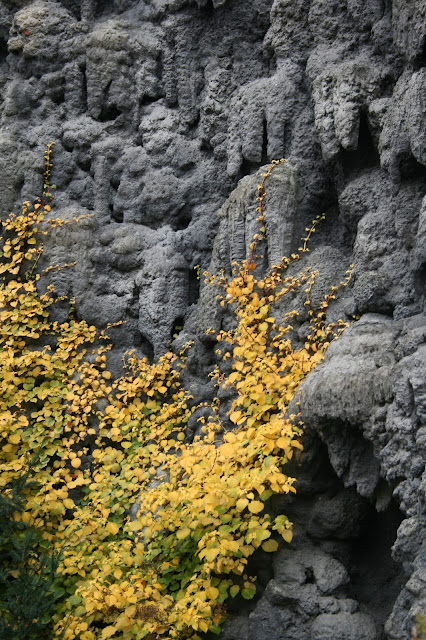Prague (pron.: /ˈprɑːɡ/; Czech:
Praha pronounced [ˈpraɦa] is the capital and largest city of the Czech
Republic. It is the fourteenth-largest city in the European
Union. It is also the
historical capital of Bohemia proper. Situated in the north-west of
the country on the Vltava
river, the city is home to about 1.3 million people, while its larger urban zone is estimated to have a
population of nearly 2 million. The city has a temperate
oceanic
climate, with warm summers and chilly winters. - From Wikipedia.
In October 2012 I was lucky enough to re-visit the wonderful city of Prague in the Czech Republic. It was a very special visit to the romantic capital as it was my honeymoon!
Any city with a skyline showing off beautiful buildings, a castle, powder towers, trees on Petřín Hill, observation towers and the fabulous Charles Bridge has got to be special.
There are so many things to see and do in Prague that even in my two visits I have not done everything I wanted to do. I have, however, taken over 1500 photos of the beautiful city, its landmarks, trees, paving stones, people and bars.
The Astronomical Clock or the Prague Orloj is one of Prague's most famous landmarks. Installed in 1410, it has been repaired many times and was heavily damaged when the south-west part of the Old Town Square came under fire from German armoured vehicles and anti-aircraft guns. The clock has many fantastic features such as the astronomical dial with its zodical ring, old Czech time scale, lunar and solar clocks. Animated figures represent vanity, greed, death and pleasure. Twelve apostles can also be seen coming into view just above the clock dial as the clock strikes the hour. The wonderful calendar created by Josef Mánes was added in 1870.
Across the other side of the Old
Town Square is the Church of Our Lady before Týn, towering above the
street performers, Svařák (mulled wine) sellers and the Jan Hus
Memorial. It's an amazing Gothic, 14th Century church that, as well as
the Castle, dominates the city.
Also in Staroměstské náměstí (Old Town Square) is Dům U Minuty, The 'House at the Minutes' with a sgraffito façade dating back to 1611. Author Franz Kafka lived here as a boy.
Talking of Franz Kafka, we also visited the open air plaza outside the Kafka Museum to see David Cerny's sculpture 'Piss'. Featuring two animatronic men relieving themselves into a puddle the shape of the Czech Republic, the sculpture attracts a lot of attention!
I enjoyed the humour of the
sculpture but also thought it was a beautiful work of art. After
researching the sculpture I found pictures of the bronze men before the
patinantion had turned the them green. I prefer it now to be honest. I
also found out that the streams of water used to spell out quotes from
famous Czech people.
David Cerny sculptures can be seen in other parts of Prague as well. The Žižkov
Television Tower, itself and interesting architectural work, was built
in the 1980s and in 2000 several of Cerny's crawling babies were
attached to the transmitter tower.
Walking along the banks of the Vltava River we came across some more babies!
We
couldn't go to Prague without visiting the fantastic Veletržní Palace
to take in some Klimt, Van Gogh, Mucha, Monet and Cezanne. We walked to
the museum whilst heavy snow fell.
Prague is beautiful in the snow. Both times I have visited it has snowed which has also meant it was bitterly cold!
In Malá Strana is the Lennon Wall, a graffiti splattered memorial created
after John Lennon was shot in 1980. It is constantly getting
're-painted' by fans and apparently the secret police were trying to get
it covered up for a long time.
A few streets away from the freedom of speech symbol that is the Lennon Wall is a small bridge over the Vlata River which can be seen from the Charles Bridge. The railings are adorned with colourful padlocks and in the water beneath the bridge lie countless keys. Couples have been locking their padlocks and throwing away the keys for years now to symbolise their love for one another. Railings all around this area are now groaning under the weight of hundreds of padlocks as the original bridge railings are full up!
Food and drink featured highly in our holiday. We wanted to experience the culture in every way possible. We found some amazing places to eat and drink.
 |
| Hot street wine! |
_cropped.jpg) |
| U Černého Vola, a lovely 'local' pub |
 | ||
| Bio Oko, a retro cafe in an arthouse cinema |
_cropped.jpg) |
| Beautiful blue railings outside Maisel Synagogue in Josefov |
The area of Josefov was really interesting, we went to most the Synagogues in the area which was both amazing and sobering. In the Pinkas Synagogue the walls are lined with almost 80,000 names of Moravian and Bohemian Jews who perished in World War II as well as a room full of drawings by children deported to Terezín, some of which survived but many were then deported to Auschwitz.
 |
| Jewish Cemetery |
.JPG) |
| Snow at St Agnes's Convent |
On a snowy evening walking down the river path we spotted St Agnes's Convent. We haven't been in but you have to leave some things for the 'next visit'!
.JPG) |
| A beautiful door at Vyšehrad |
.JPG) |
| Interior of Vyšehrad |
Vyšehrad, Pragues other castle as it is often known, is spectacular. Within the castle walls are the basilica of St Peter and St Paul and the Vyšehrad cemetery. Near the castle is the Rotunda of St. Martin, often believed to be the oldest building in Prague. There are fantastic views across the river and up towards the castle and Charles Bridge from the hill on which Vyšehrad sits. We had a lovely walk through the leafy cobbled streets, found some conkers and spotted the lovely sparkley grave of Antonín Dvořák in the cemetery.
 |
| Jubilee Synagogue near Central railway station |
After wandering past the Opera House where we would later be seeing Verdi's Rigoletto we stumbled upen the Jubilee Synagogue, tucked away in a side street called Jerusalem Street. The Synagogue was built in 1906 with Art Nouveau and Moorish influences and it is stunning.
Coming out of Jiřího z Poděbrad Metro staion you are met with the sight of The Church of the Most Sacred Heart of Our Lord. It's an impressive sight, square and blocky, with a façade of brown glazed bricks and an enormous see-through clock. The structure was completed in 1932 by Jože Plečnik who also was involved with the renovation of the castle. The Sacred Heart takes influences from cubism, classical Greek structures, Egyptian temples and Christian basilicas.
The Wallenstein Gardens and the Wallenstein Palace are a real hidden gem of Prague. Peacocks and ducks wander amongst tourists taking in the views up to the castle and locals eating their lunch. Beautiful gardens boosting topiary and box hedges as well as bronze statues and a pond complete with fountain surrounds a Palace that is home to the Czech Senate.
 |
| Dripstone wall in Wallenstein Gardens |
The Dripstone Wall or Grotto is a wall with artificial stalactites imitating a limestone cave. Hidden creatures worked into the stone peer out from different places. It is pretty odd but strangely appealing and quite picturesque with the lovely yellows and reds of the the leaves on the surrounding trees.
 |
| Franz Kafka Monument |
 |
| Municipal House |
 |
| Golden Lane |
 |
| St Vitus Cathedral in Prague Castle |
 |
Autumn is a great time to visit Prague. The leaves are turning, there is a chance of snow, there are less tourists and did I mention the hot street wine?
 |
| Prague from Petřín Hill |
Petřín Hill can be seen from most places in Prague. It is more than just a hill however. On the hill you can find a hunger wall, mirror maze, rose garden, a funicular railway, a wooden church, Strahov Monastery and the Petřín lookout. The walk up and down is great with beautiful views.
 |
| Loreta |
Even the metro stations are beautiful!













.JPG)








No comments:
Post a Comment